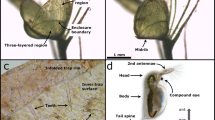Summary
The aim of this report is to answer the following questions: a) To what extent does the prey-catching activity of a toad change as the distance between it and a prey-dummy changes while at the same time the size of the visual angle or the absolute size of the dummy are held constant? b) Does the toad prefer a particular angular size in order to catch prey or can it recognize—irrespective of the distance— a particular absolute object size which is optimal for its behaviour?
-
1)
For constant absolute or visual angular size of a prey-dummy, the prey-catching turning activity generally falls off with increasing distance between animal and dummy (Fig. 2).
-
2)
If square dummies are presented to toads from a constant distance, then a particular dummy size elicits maximal prey-catching activity. When the distance is varied, this optimal size remains constant when measured in absolute units of length (“size-constancy” phenomenon); the edge length of such an optimal dummy is of about 7 mm (Table 1). On the visual angle scale (which is not absolute), the optimal value accordingly shifts towards smaller values for distant objects, towards larger values for objects nearer to the animal (Fig. 4).
-
3)
For the orientingturning reaction of the prey-catching sequence object size-constancy is independent of binocular vision (Table 1; compare Fig. 4A and B). However, insnapping behaviour, this phenomenon is linked to the information leaving both eyes (Table 1; compare Fig. 5A and B).
-
4)
It was not possible to demonstrate the size-constancy phenomenon after the thalamus-pretectal region has been destroyed. Presumably it is in the nuclei of this region that one should look for neurons which—like certain cells in the human visual cortex—“fit” their excitatory receptive field size to the specific object distance in question.
Zusammenfassung
In der vorliegenden Arbeit sollten folgende Fragen beantwortet werden: a) Inwieweit ändert sich die Beutefangaktivität der Erdkröte, wenn man die Distanz zwischen Tier und Beuteobjekt variiert und hierbei die Sehwinkelgröße oder die absolute Objektgröße konstant hält? b) Bevorzugt die Kröte unter Beuteobjekten stets eine bestimmte Sehwinkelgröße oder erkennt sie — unabhängig von der Distanz — eine bestimmte absolute Objektgröße als optimal für ihr Fangverhalten.
-
1.
Bei konstanter Absolut- oder Sehwinkelgröße einer Attrappe sank die Beutefangwendeaktivität generell mit zunehmender Attrappen-Distanz ab.
-
2.
Unter quadratischen Objekten, die der Kröte in konstantem Abstand geboten wurden, löste eine bestimmte Größe maximale Beutefangaktivität aus. Bei Variation des Abstandes blieb diese optimale Größe über der metrischen Skala konstant („Größenkonstanz-Phänomen”); siebetrug ca. 7 mm Kantenlänge. Dementsprechend verschob sich der Optimalwert auf der Sehwinkelgradskala für entfernte Objekte in Richtung kleiner Werte, für nahe in Richtung großer.
-
3.
Objektgrößenkonstanz war für die orientierendeWendereaktion des Beutefangs auch bei einäugigen Kröten nachweisbar.Im Schnappverhalten war dieses Phänomen jedoch an das binokulare Sehen gebunden.
-
4.
Nach Ausschaltung der Thalamus-Praetecum-Region waren Größenkonstanz-Phänomene nicht mehr eindeutig nachzuweisen. Vielleicht sind in diesem Kerngebiet Neurone zu suchen, die — ähnlich wie im visuellen Cortex des Menschen — ihre excitatorischen rezeptiven Feldgrößen der jeweiligen Objektdistanz über „z-Achsen-Lokalisationsmechanismen” anpassen.
Similar content being viewed by others
Literatur
Ewert, J.-P.: Untersuchungen über die Anteile zentralnervöser Aktionen an der taxisspezifischen Ermüdung beim Beutefang der Erdkröte (Bufo bufo L.). Z. vergl. Physiol.57, 263–298 (1967).
Ewert, J.-P.: Der Einfluß von Zwischenhirndefekten auf die Visuomotorik im Beute- und Fluchtverhalten der Erdkröte (Bufo bufo L.). Z. vergl. Physiol61, 41–70 (1968).
Ewert, J.-P.: Quantitative Analyse von Reiz-Reaktionsbeziehungen bei visuellem Auslösen der Beutefangwendereaktion der Erdkröte (Bufo bufo L.). Pflügers Arch.308, 225–243 (1969).
Ewert, J.-P.: Aufnahme und Verarbeitung visueller Informationen im Beutefang- und Fluchtverhalten der Erdkröte (Bufo bufo L.). Verh. dtsch. zool. Ges.64, 218–226 (1970).
Ewert, J.-P.: Single unit response of the toad's (Bufo americanus) caudal thalamus to visual objects. Z. vergl. Physiol.74, 81–102 (1971).
Ewert, J.-P.: Neuronal basis of visually guided behavior. Sci. Amer. (in press) (1973a).
Ewert, J.-P.: Lokalisation und Identifikation im visuellen System der Wirbeltiere. Fortschr. Zool.21, 307–333 (1973b).
Ewert, J.-P., Speckhardt, I., Amelang, W.: Visuelle Inhibition und Exzitation im Beutefangverhalten der Erdkröte (Bufo bufo L.). Z. vergl. Physiol.68, 84–110 (1970).
Eysel, U. Th., Grüsser, O.-J.: Neurophysiological basis of pattern recognition in the cat's visual system. In: Pattern recognition in biological and technical systems, O.-J. Grüsser, R. Klinke, eds. Berlin-Heidelberg-New York: Springer 1971.
Hubel, D.-H., Wiesel, T. N.: Stereoscopic vision in the macaque monkey. Nature225, 41–44 (1970).
Ingle, D.: Visual releasers of prey-catching behavior in frogs and toads. Brain, Behav., Evol.1, 500–518 (1968).
Marg, B., Adams, J.-B.: Evidence for a neurological zoom system in vision from angular changes in some receptive fields of single neurons with changes in fixation distance in the human visual cortex. Experientia (Basel)26, 270 (1970).
Schneider, D.: Das Gesichtsfeld und der Fixiervorgang bei einheimischen Anuren. Z. vergl. Physiol.36, 147–164 (1954).
Author information
Authors and Affiliations
Additional information
Mit Unterstützung der Deutschen Forschungsgemeinschaft Ew 7/6 und Az.: 741,29.
Rights and permissions
About this article
Cite this article
Ewert, J.P., Gebauer, L. Größenkonstanzphänomene im Beutefangverhalten der Erdkröte (Bufo bufo L.). J. Comp. Physiol. 85, 303–315 (1973). https://doi.org/10.1007/BF00694236
Received:
Issue Date:
DOI: https://doi.org/10.1007/BF00694236



